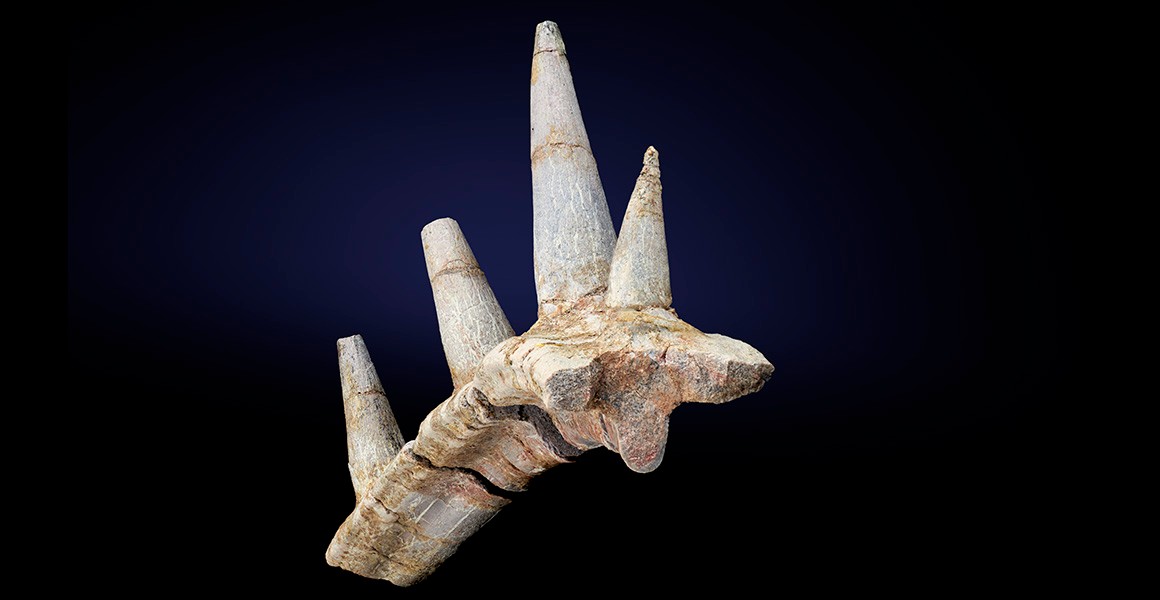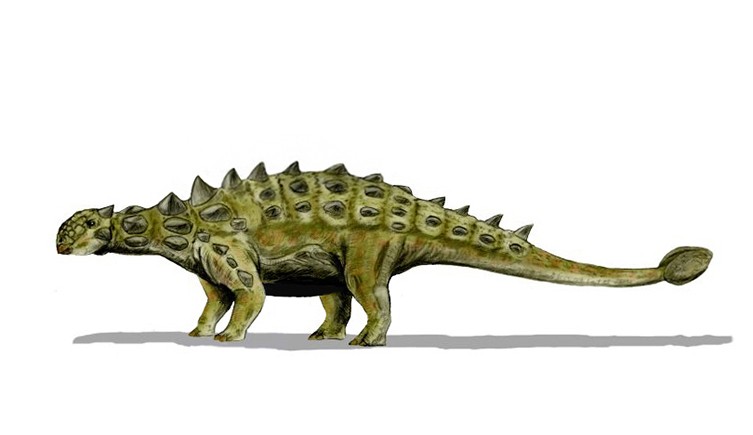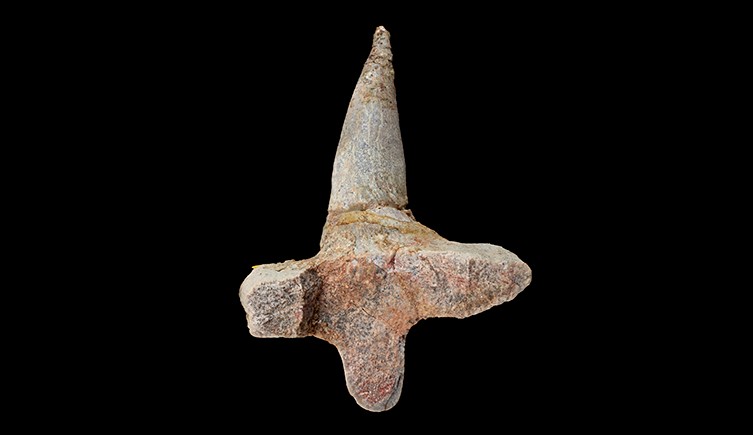Create a list of articles to read later. You will be able to access your list from any article in Discover.
You don't have any saved articles.

The rib bone is unusual. The animal's armour plate is fused to the surface of the bone.
A new species of ankylosaur is unlike any other dinosaur found to date.
The new dinosaur is not only the oldest ankylosaur ever discovered and the first to be found on the African continent, but also had bony spikes projecting from its ribs, a feature not seen in any other vertebrate species living or extinct.
A new dinosaur fossil from Morocco dating to 167-163 million years old is thought to be the oldest ankylosaur ever discovered.
These armoured, herbivorous dinosaurs are fairly well known from the northern continents, but this is the first time that the remains of one has been found from Africa.
What's more, the fossil ribs show a feature not seen in any other animal: the protective spikes that once would have lined the sides of this animal are actually fused to the rib bones themselves.
Excitingly, the new fossil also comes from the same site where Adratiklit boulahfa - the oldest known stegosaur and the first from North Africa - was discovered.
Dr Susannah Maidment is a dinosaur researcher at the Museum and an expert in armoured dinosaurs. She has helped to describe this new species as well as that of Adratiklit two years ago.
'Having armour fused to a rib is just totally bizarre,' says Susannah. 'It is totally unlike any extant or extinct vertebrate that we are aware of. We don't see this phenomenon of an osteoderm fusing to a rib in any other vertebrate, living or dead.
'It is difficult to come up with analogues, really, because they aren't any.'
The new fossil has been described in the journal Nature Ecology and Evolution and named Spicomellus afer.

Ankylosaurs, such as this Euoplocephalus, were herbivorous dinosaurs with armoured plates covering their backs © N. Tamura/Wikimedia Commons
Ankylosaurs are a group of dinosaurs typically known for the extraordinary bony armour that once covered their backs.
The sister group to the more famous stegosaurs, they had rows of bony plates embedded into their skin, some of which would form huge flat plates while others grew outwards as spikes. Some species had a large bony club on the end of their tails.
'Ankylosaurs were small, armoured dinosaurs that are kind of like walking coffee tables,' says Susannah. 'They were very broad and very wide, but they had short legs.
'They had transverse rows of armour, meaning that the armour extends from the midline of their body out to the sides.'
In all known species of ankylosaurs, this armour would have been embedded in their skin, meaning that this new fossil in which the armour is physically fused to the bones is unlike anything seen before.
So different is this new fossil that at first Susannah and her colleagues weren't even sure what animal it once belonged to.
'When we got the fossil, we thought it was probably part of a stegosaur because we'd found a stegosaur at the site from which it originates,' explains Susannah. 'But we just don't see stegosaurs with this sort of armour.
'We therefore decided to histologically section the fossil, or cut it up. We made thin sections of the fossil and what this showed us, excitingly, was that the bone structure in the spike parts has a signature that we only see in ankylosaurs from this period.'

The cross-section of the rib shows a 't-shape', which is distinctive to ankylosaurs and stegosaurs
Despite their first thoughts, this allowed the researchers to say with some degree of confidence that the bones actually belonged to an ankylosaur.
This is of huge significance because not only had ankylosaurs never been found on the African continent, but the age of the fossil also makes it the earliest ankylosaur ever discovered.
The fossil is in fragments, so it is difficult to figure out exactly what this extraordinary animal once looked like. But some inferences can be made.
'If you think of animals like crocodiles which have bony scutes embedded in the skin, it is probable that the flatter part of the osteoderm would have been covered in some sort of skin,' explains Susannah. 'Then the spikes that are projecting are kind of just a horn core and would probably have been covered in a keratinous sheath, like the horn of a cow.'
It is impossible to know how the spikes became fused to the bone, whether this ankylosaur was an early experimentation in armour for ankylosaurs or whether this species was just a one-off. Susannah hopes that by returning to Morocco in the future they might be able to uncover more bones.
The geography of the world during the Jurassic was vastly different to today.
The continents were, broadly speaking, split into two separate major landmasses. In the northern hemisphere the land formed a super continent known as Laurasia, while in the south the land formed the gigantic Gondwana.
These two continents were separated by open water, limiting the ability of animals and plants to cross from one landmass to the other.

The histological sectioning of the bone showed that the spikes had a tissue type only seen in ankylosaurs during the period the animal was alive
The remains of ankylosaurs are frequently found in the rocks that formed Laurasia in the north, with multiple species described from the USA, Canada and Europe. But the extent of the dinosaurs in the more southern Gondwana has long been something of a mystery.
Despite having formations of rock dating to the right age, until now only one fossil of an ankylosaur has been described from Gondwana.
'There are other fragmentary remains that suggests ankylosaurs were in Gondwana,' says Susannah. 'But until this point it seemed that they were maybe just a small part of the ecosystem.
'We have these tantalising fossils, but they don't tell us much about the diversity of ankylosaurs in Gondwana. All they seem to suggest is they were pretty rare.'
This discovery might help shift that picture a little.
Despite the fossil being acquired from a dealer in the UK, the researchers know it originated from a site in Morocco which they are already working with local palaeontologists and government officials to excavate.
A memorandum of understanding is allowing the researchers to work with Moroccan institutes and scientists to uncover and describe these new species. The goal is to set up a new museum in the country, where these incredible finds can be cared for and put on display not far from where they originated.